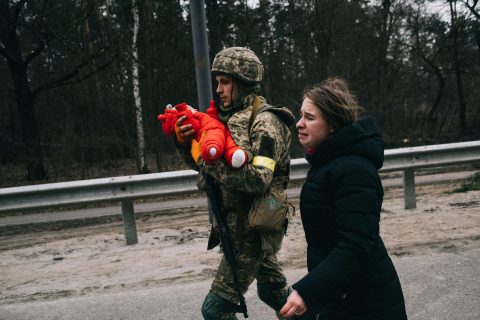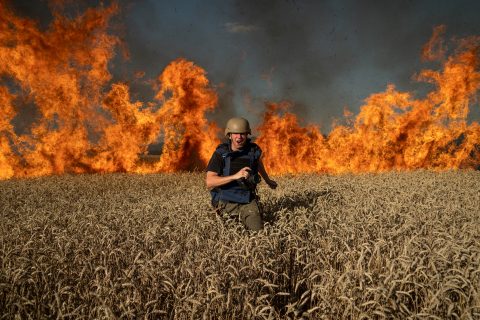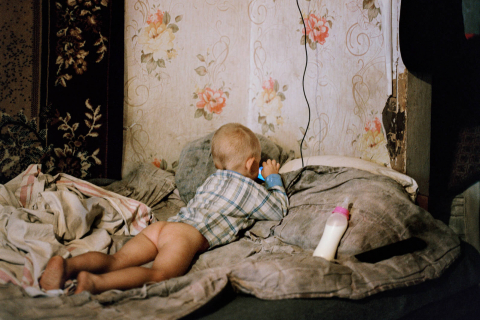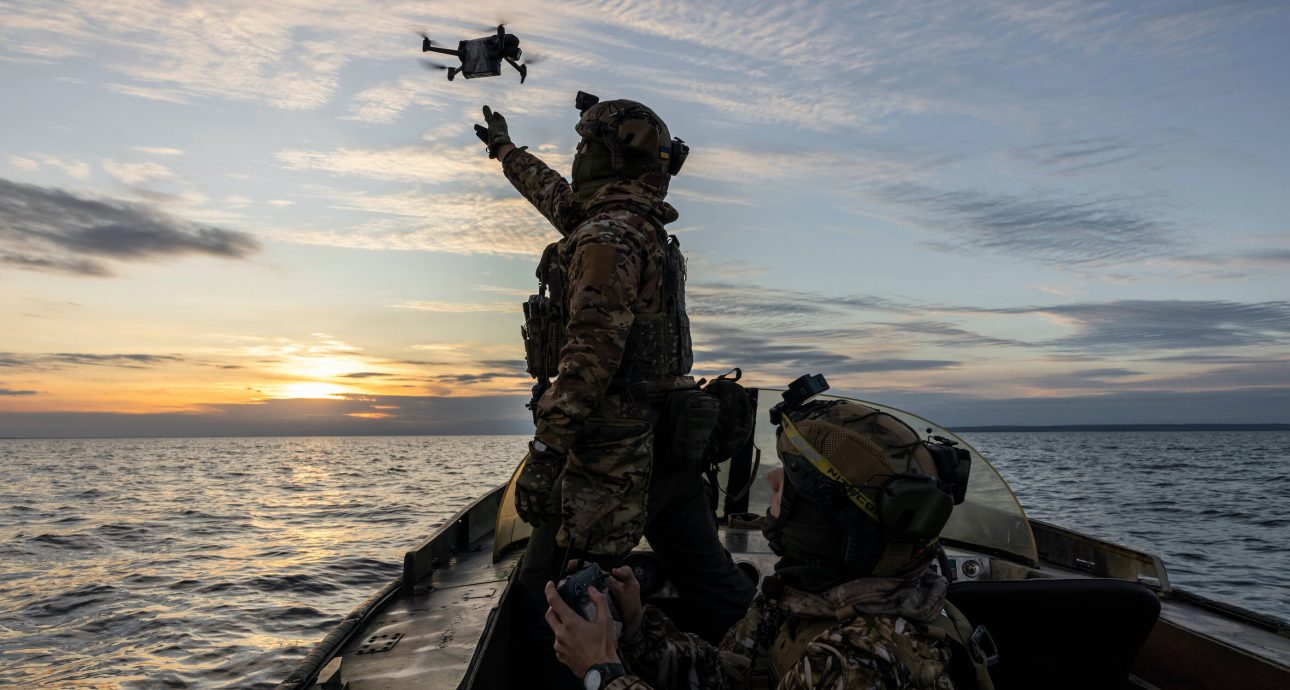
Ivor Prickett’s Ten Iconic Photos of War
An Irish photographer Ivor Prickett spent over ten years in the Middle East, covering the events in Iraq and Syria. But in 2022, together with The New York Times team of journalists, he came to Ukraine to show the world that a big war was raging in Europe again. Ivor’s work has numerous awards, including World Press Photo, The Pulitzer Prizes, The Overseas Press Club Awards, Pictures of the Year International, Foam Talent, and others.
The railway station

I’m not an expert on Ukraine and Russia, it’s not my usual area. I’m based in Istanbul and I’ve covered the Middle East for the last ten years. But when the Russian full-scale invasion started, I came to Ukraine as a part of The New York Times team. I knew about the situation only from the media and from what we saw on the ground. When I think back about Russia launching a horrifying full-scale attack, honestly, it seemed that Ukraine wouldn’t last that long.
We were stationed in Lviv and covered the mass exodus of people, who were fleeing the country. This photo was taken at the Lviv railway station at the beginning of March. Thousands of people were coming through the station every day, trying to escape the war. It was freezing cold. Those scenes reminded me of World War II. People were so terrified. We couldn’t believe that it was happening and didn’t know what to expect. This picture captures the sense of panic and chaos of those days.
The firefighter
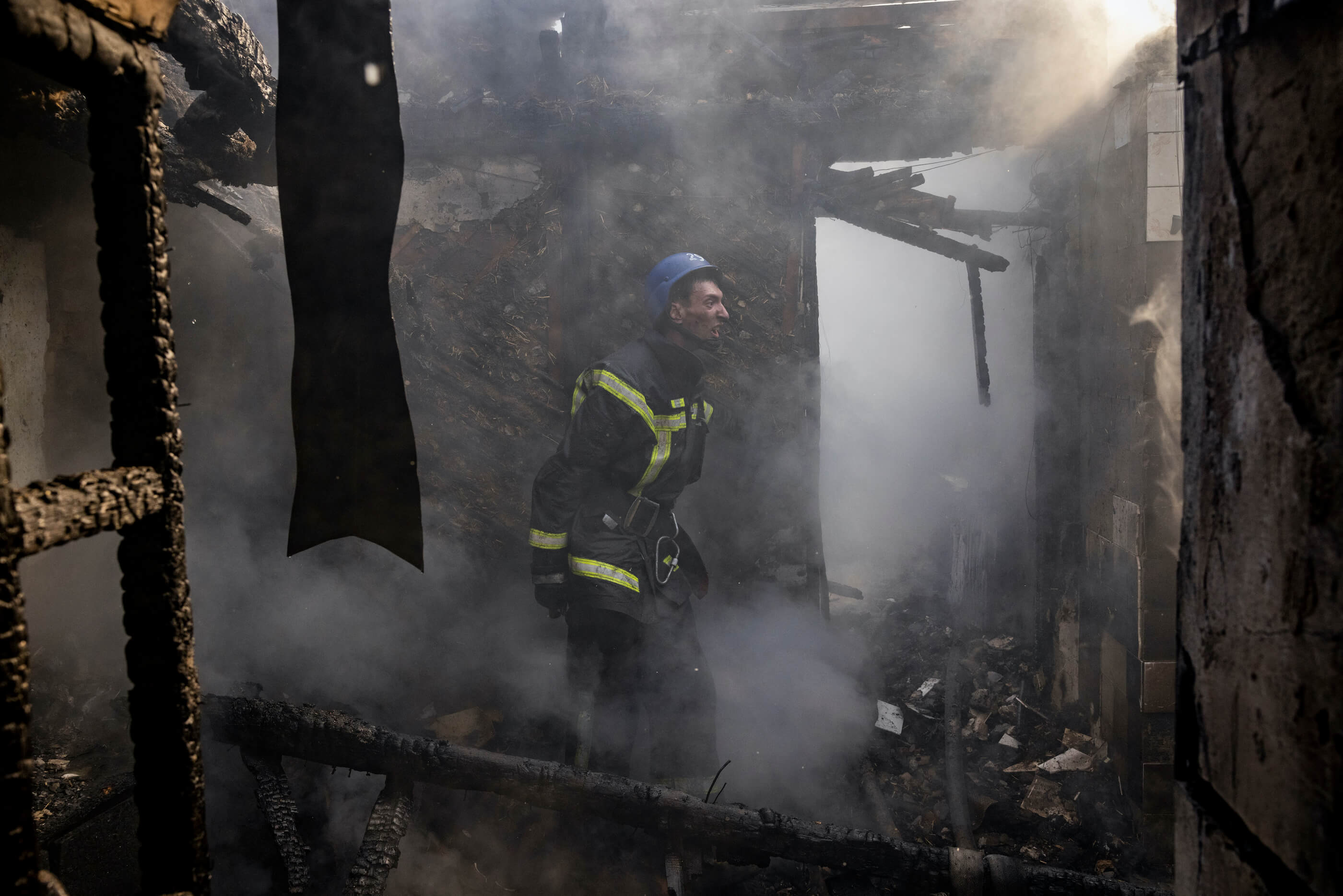
I moved from Lviv to Kyiv in early March. As you know, at that time we were on a daily watch for missile strikes. This strike stuck with me more than others. Partly, because of this photograph. But partly, because on that day, around 23-24 of March, Russians got the closest to the city and managed to fire Grads.
They shelled the Nyvky district in Kyiv. We got there as soon as we could and saw that a series of small residential homes had been hit. Luckily, no one died. But I realized immediately that Russians fired Grads or other MLRS. And that was a scary perspective for everyone. Because it’s not the same as long-range missiles. We can’t really defend against Grads, we have no time to warn people and find shelter. It all happens so fast. I remember thinking that we should expect more of this kind of shelling. Luckily, the Ukrainian forces managed to push Russians back from Kyiv and other northern regions.
To take this picture, I walked inside a building that was on fire. It sounds scary, but I’ve been doing this kind of thing for quite a while. At The New York Times, we have very strict security protocols. We work with security advisors and invaluable local fixers who help us navigate on-site. But I also often rely on my personal instincts. I have over ten years of covering conflicts and I know when to push the limit. You have to do it as a photographer because you can’t build a story by talking to people in the safety of your hotel room. You have to go outside and take risks, but you also have to know when to step back. In this case, it was a bad fire, but I could tell that the firefighters got it under control. So it was worth it to go inside. I quickly took a few pictures and got out of their way.
Bucha
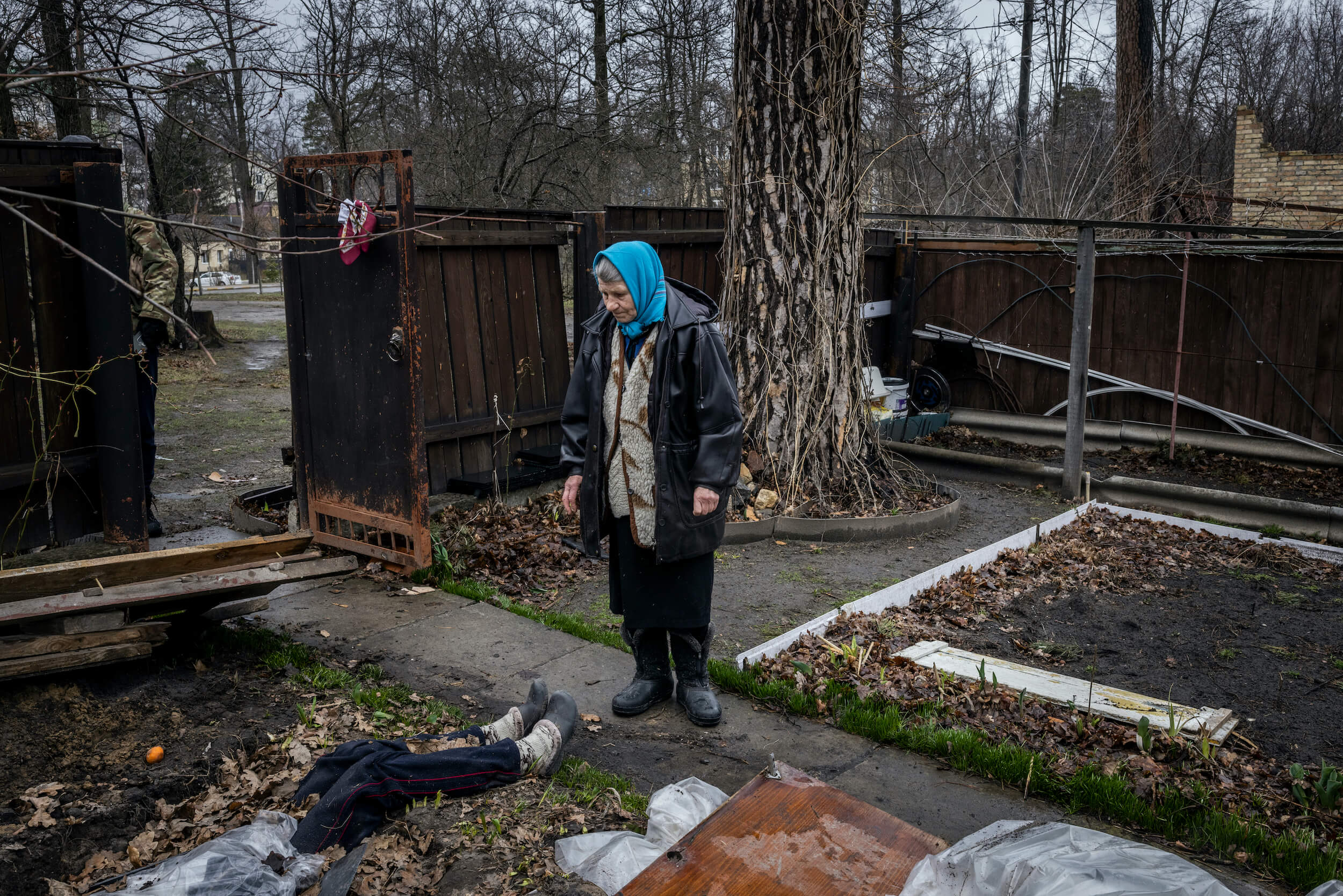
Bucha was and remains one of the most troubling moments in this war. Especially for those who endured it and suffered under the Russian occupation. I got in there on the second day after the first journalists had been allowed into the town. There were still bodies on the streets. A lot of buildings were destroyed. I’ve covered many conflicts and humanitarian disasters, but I’ve never seen anything as ordinarily brutal as that. I would drive through what you could tell was a leafy, nice, vibrant neighborhood, and then suddenly I would see someone’s arm or leg. At some point, I spotted a car that was crushed by a Russian armored vehicle. I approached it to take a picture and realized that there was someone’s body sitting in the driver’s seat. It was so surreal. It’s hard to describe a contrast between a perfectly normal suburb and the macabre violence that swept through it.
In this photo, Antonina is looking at the body of her daughter, who was killed by the Russians. They were coming into the city from the north and she went to the gate of her home to see what was going on. They shot her through the fence. Her mother half-buried her in the front garden. She remained there during the whole month of the Russian occupation. We came to Antonina’s house with a group of Ukrainian officials. They uncovered the body temporarily to document the war crime. Then they left the yard and I saw Antonina looking down at her dead daughter. That’s when I took the picture.
I think that I always had this inner understanding of when it is okay to take a photo. Because a lot of the time we don’t even have a chance to ask for permission. There is a fine line that we have to walk as photojournalists. When you are photographing something like this, you have to be very physically respectful. Try not to get too close, not to take too long, not to stick your camera into people’s faces as they go through their toughest moments. But you would be amazed by the amount of gratitude we get from people in these situations. They want their stories to be told.
The tank
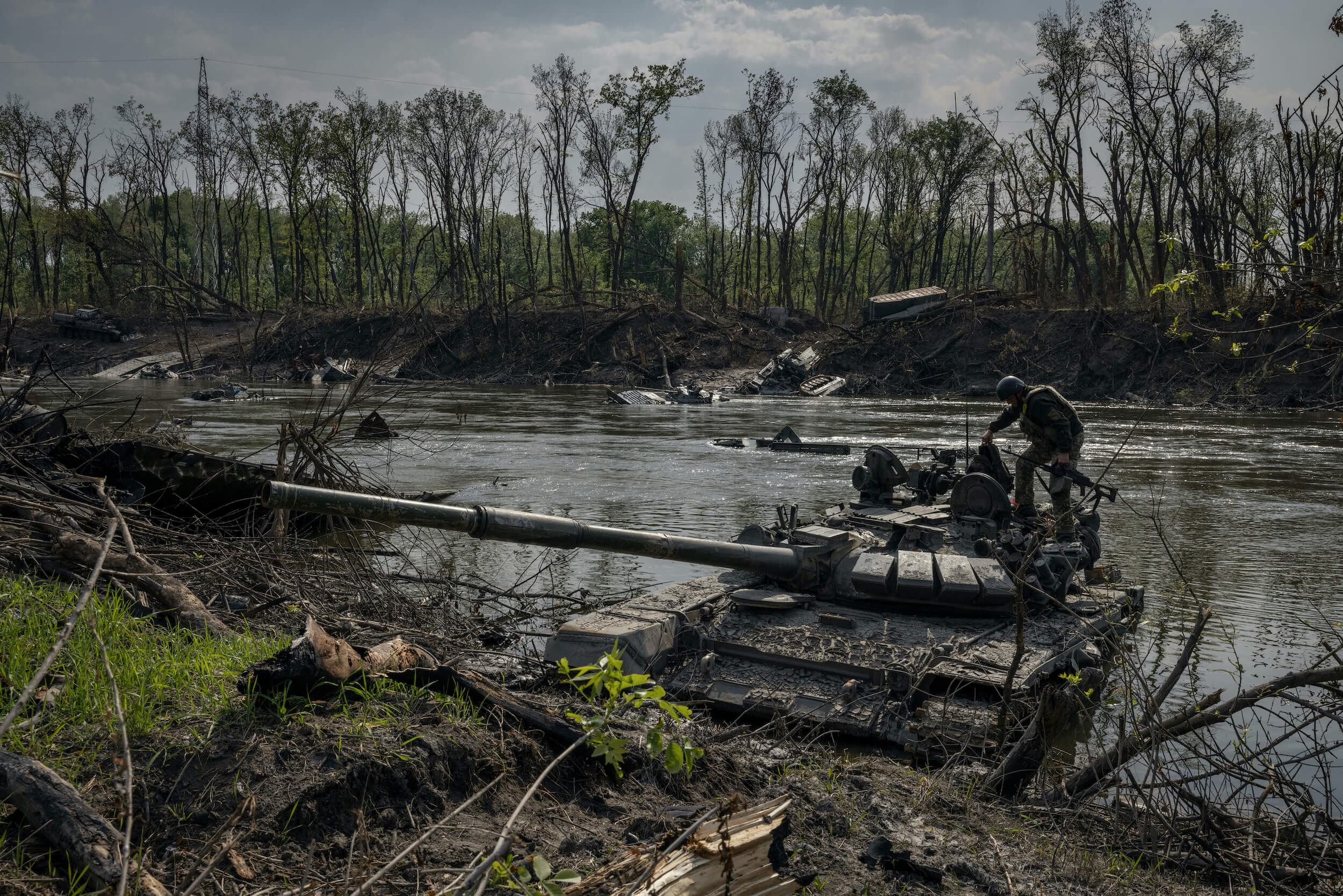
This photo was taken in Bilohorivka, in May 2022. The Russians had attempted to cross the Syverskyi Donets river to encircle Ukrainian troops, who were in Lysychansk and Severodonetsk areas. The Ukrainians spotted their attempts to cross the river and Russian tanks were utterly routed.
You can see a lot of destroyed Russian vehicles in this picture. There are even remnants of the pontoon bridge on the other side. I don’t think any other journalists got so close to the river as we did. Actually, we didn’t plan to go that far, either. We thought that we would go into the forest and take pictures of destroyed tanks in the woods. But a Ukrainian serviceman, who was escorting us, was like: “Do you wanna go a little bit further?”. And of course, as a photographer, I always want to go a little bit further. So off we went.
He led the way and checked the road, which was covered with mines, unexploded ordinances, and bodies of dead Russians. We slowly followed him. Then we got to the river and I couldn’t believe that we were going into the open area. I asked him: “Aren’t the Russians still there, on the other side?”. And he said: “Yeah, maybe”. So I thought, it was not a good idea, but I wanted to photograph this scene which showed Russia’s catastrophic loss. And still, I was half-waiting for a shot from the other bank. Our brave guide jumped on the tank and managed to take out a machine gun and a backpack, which was full of documents. He was very happy with himself. I think we both got what we wanted.
The evacuation
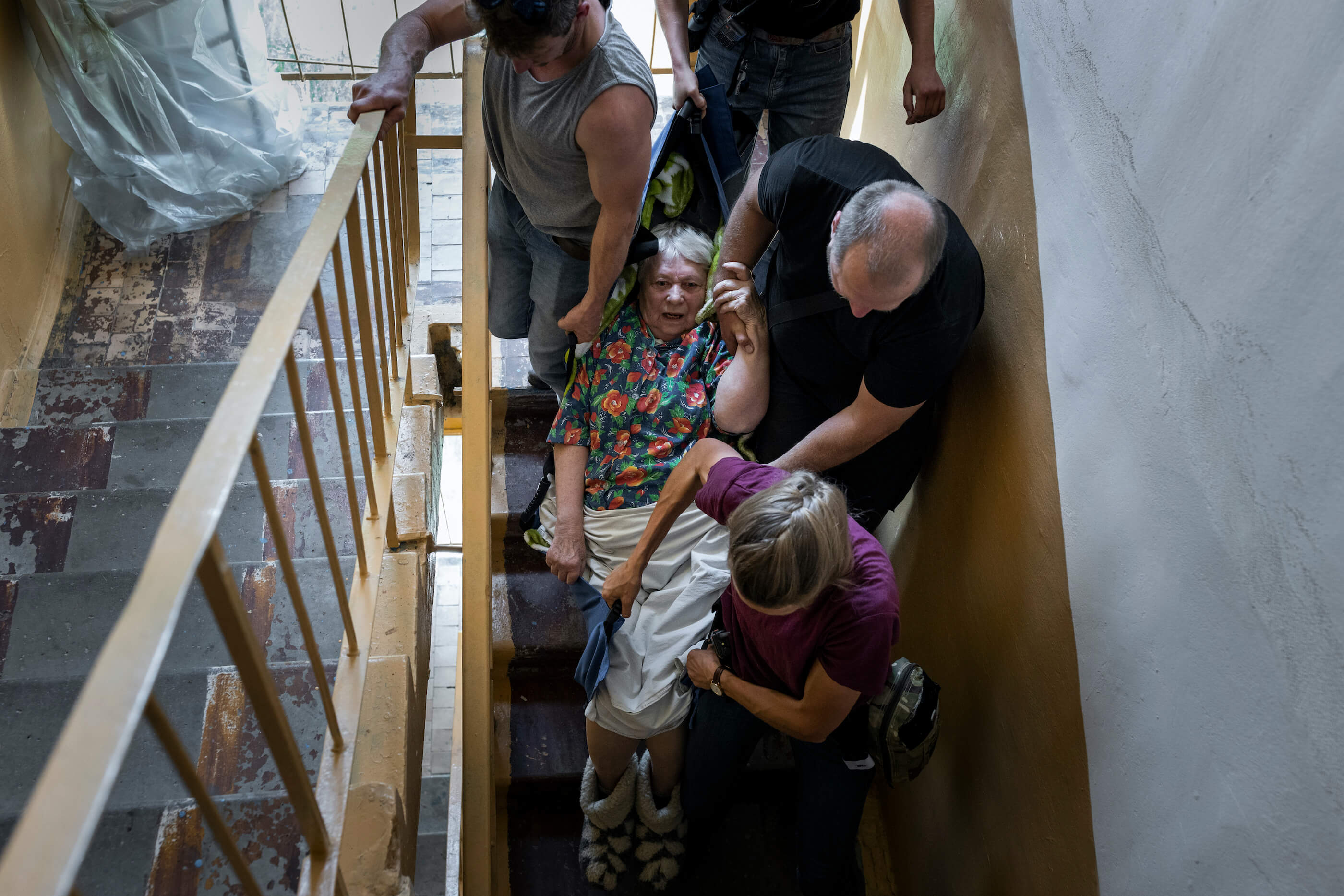
I met the Vostok SOS group while working in the Donetsk region. This group has been operating since 2014, helping civilians to evacuate from the frontline areas. Particularly, they evacuated the vulnerable — elderly people, people with disabilities, and others.
This woman’s name is Zinaida. Her story struck a chord with me. She lived in Bakhmut and she was blind. Just imagine it: living in a city that is constantly shelled and not being able to see what’s going on, where is the danger. That seemed so scary to me. She was one of the many people the Vostok SOS evacuated over the three or four days I followed them in May 2022.
Their group was very well organized. They planned their missions carefully and made sure they had enough room to accommodate the people they evacuated. So things went smoothly and efficiently with them. But I’ve also seen many other people in other areas, who were reluctant to leave, even though their cities were half destroyed. It’s hard to understand why they are staying. But I know from my long-standing experience of covering wars and refugee crises that people always want to stay home. Some of them don’t have money to go anywhere. However, it’s not all about that. For some unfathomable reasons, people will do everything they can to stay in their homes. And those, who have left, will do everything they can to return. I saw people, who came back to their demolished houses years after the conflict and tried to rebuild them. It can seem crazy, but a strange connection between a person and a home is hard to break. Even missiles can’t destroy this bond.
The injured
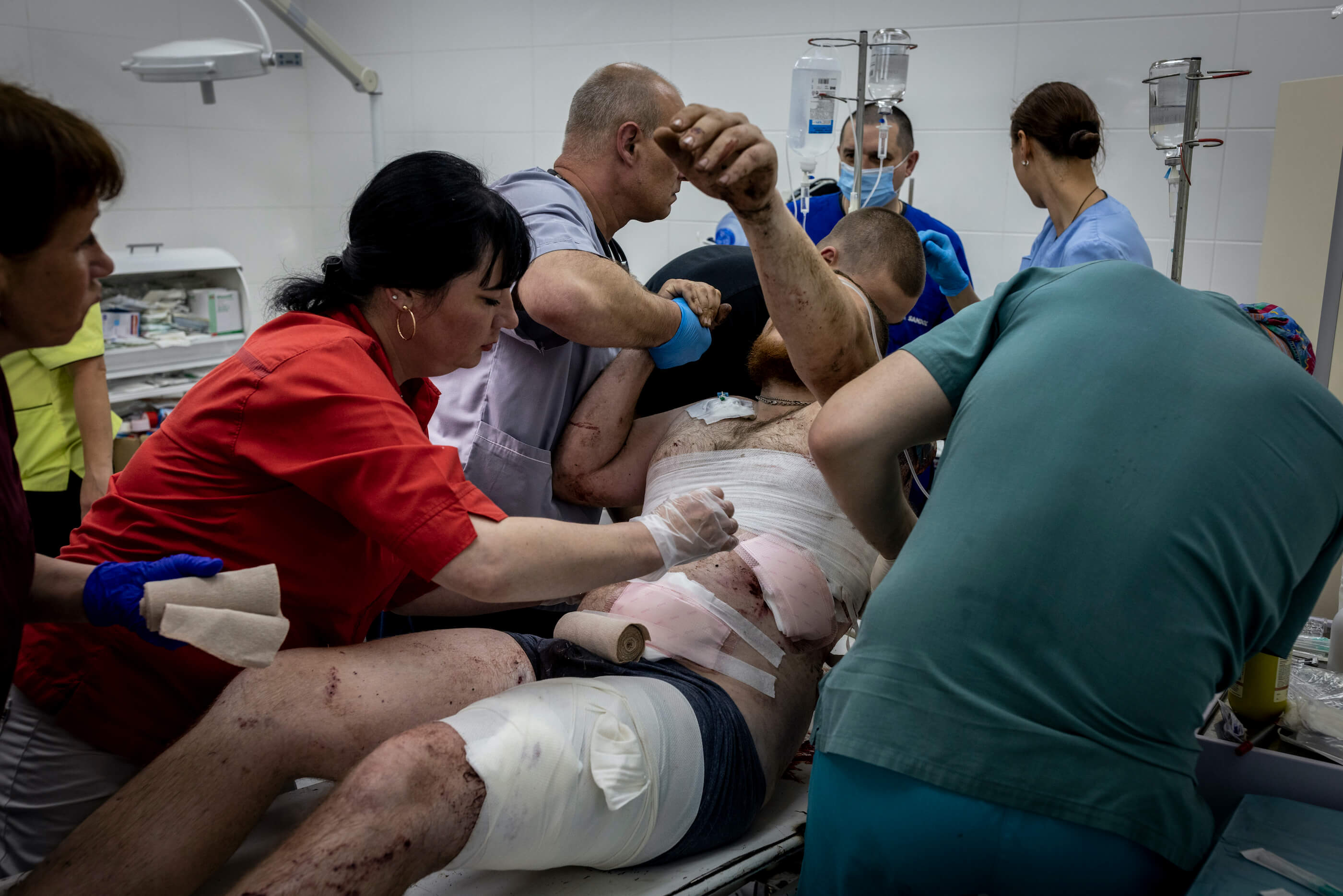
This is in Slovyansk, in June 2022. It was the time of severe fights for Severodonetsk and Lysyschansk. Back then, Russia still had superior firepower over Ukraine, it was before HIMARS arrived. The casualties rates were probably at the highest since the beginning of the full-scale invasion. A lot of people had shrapnel injuries from artillery shelling.
We wanted to show the world what cost the Ukrainians were paying in this war. It was hard to get access to hospitals, but, eventually, we started to get some permissions. This man was brought from the Izyum direction, he suffered from an artillery strike. He was badly injured but he was going to survive, they told me. The emergency stabilization hospital was located in Slovyansk, which was also shelled mercilessly. So the doctors there would provide emergency treatment and then would move patients further, to Kramatorsk or Dnipro.
Taking a picture like this is a delicate subject. As a photographer, I have to be very careful, because a person is unable to give me consent. This man wasn’t unconscious, but he was on a lot of medication and in a lot of pain. I couldn’t ask him for permission to take a photo at that moment. So I had to choose the angle and the right time to hide his identity. That’s the kind of delicacy you need to have, even amidst the chaos of a military hospital.
The blurred one
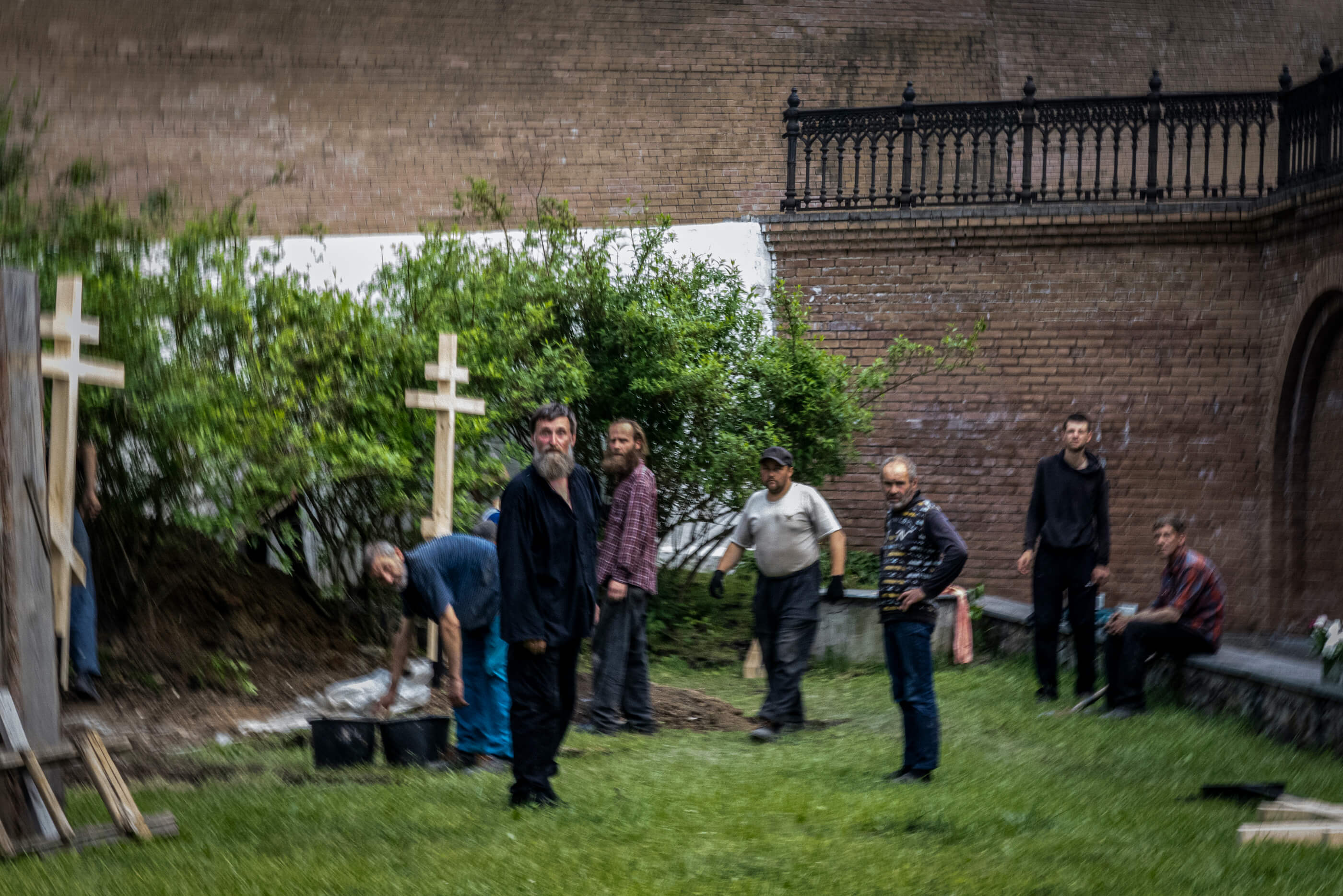
This is a bizarre photo. We arrived at the Svyatohirsk Lavra, or the Svyatohirsk monastery of the caves, when Russians were just a couple of kilometers away, trying to encircle the city. We knew that our trip was dangerous, but we wanted to show that a lot of priests and civilians were still living in the caves. We went there with the police chief of Kramatorsk and his deputy. As we were approaching, we heard the constant sound of artillery, which grew louder. It seemed like we were driving right into the front line. It’s not a good idea, I thought back then.
When we got to the monastery, a shell landed just outside the wall. The best thing to do would be to hide inside the monastery, but we ran around, like crazy, trying to find people who would talk to us. I was walking briskly across the courtyard when I saw these guys. They stood next to the crosses and looked like they were burying somebody. I took out my camera to take a picture when another shell came in right on the other side of the building. I started running and kept taking pictures as I ran. That’s how this photo was made.
The men in the picture look quite confused. I don’t think any media had been there before. Besides, they were shell-shocked and mournful. We found out later that they had been burying three of their priests, who were killed a day before in a Russian strike that landed inside the monastery. And also these men were not very friendly. They belonged to the Moscow patriarchy and, frankly speaking, they were quite pro-Russian. To me, that was something incomprehensible. We were hiding inside the stairwell of one of the monasteries, and they said: “Well, we don’t know who’s firing”. And I thought, “How can you not know? The Ukrainians are on the other side of the river. How can they fire behind themselves? Of course, it’s the Russians”. I was shocked by their reluctance to admit the obvious. They had just buried three priests, killed by the Russians, and they kept burying their heads in the sand. It was a very strange experience. And while at first I was disappointed that the photo came out blurred, now I think it shows the weirdness of that situation.
In the boat

I’m not supposed to say exactly where this one was taken. I can only say that it was somewhere in the Dnipro river system. A Ukrainian special forces unit was conducting sabotage operations at night, attacking Russian forces from the river. Those were high-risk operations. Of course, I couldn’t go with them at nighttime, because it was too dangerous. But one day they went out at the dawn to fly their drones and see if any damage was done on the Russian side. That’s when they let me join them. We went on a boat and reached a place where the river was wide and we were far away from the shore. I have to say that it was a nerve-racking experience. I knew that the Russians were standing on the other bank. But it was worth risking. I wanted to show multiple ways, in which Ukrainians fought against Russian aggression.
This picture looks beautiful. The serenity of water, the morning sun — it looks almost idyllic. But it is an image of war. As a visual communicator, I need to take pictures that will make people stop and look. So even when I’m covering war, I try to frame an engaging photo.
The dead
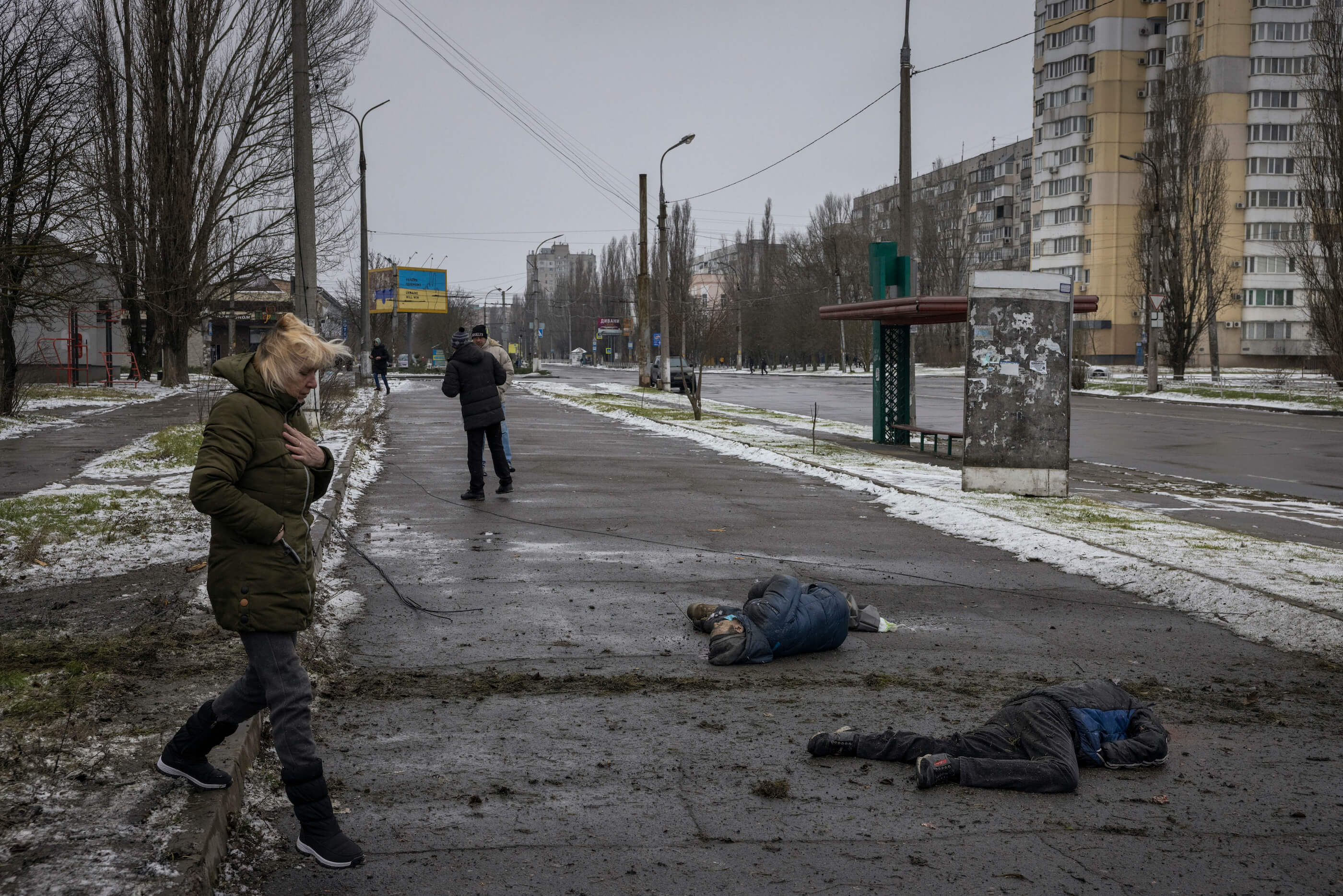
And this is an entirely different case. Unlike the previous photo, this is a difficult picture to look at. It was taken in Kherson, a month ago. The situation was very complicated. On one hand, the city was liberated and it was a big victory for the Ukrainians. But on the other hand, things became more dangerous. Kherson turned into a frontline city. During that trip, I felt very downhearted. People fought for so long, survived under Russian occupation, and now they were in even more danger. Besides, not enough journalists were covering the current situation, since the media focused mainly on the east. We thought we should try and report on what was going on in Kherson.
On this particular day, the Russian forces fired Grad rockets into the middle of the city. Four people were killed. It could have been more, but there are not so many people left in Kherson. We arrived at the spot together with the emergency services. But there was nothing to do for the doctors — the two men on the road were dead. So we waited until the police came, and for about five or ten minutes their bodies just lied on the ground and people walked past them. I looked at them and thought that anyone could have been in their place. They were just unlucky to be walking outside at the wrong time. These thoughts start messing with your head. It’s hard to comprehend that you can be killed by a missile at any moment.
In the car
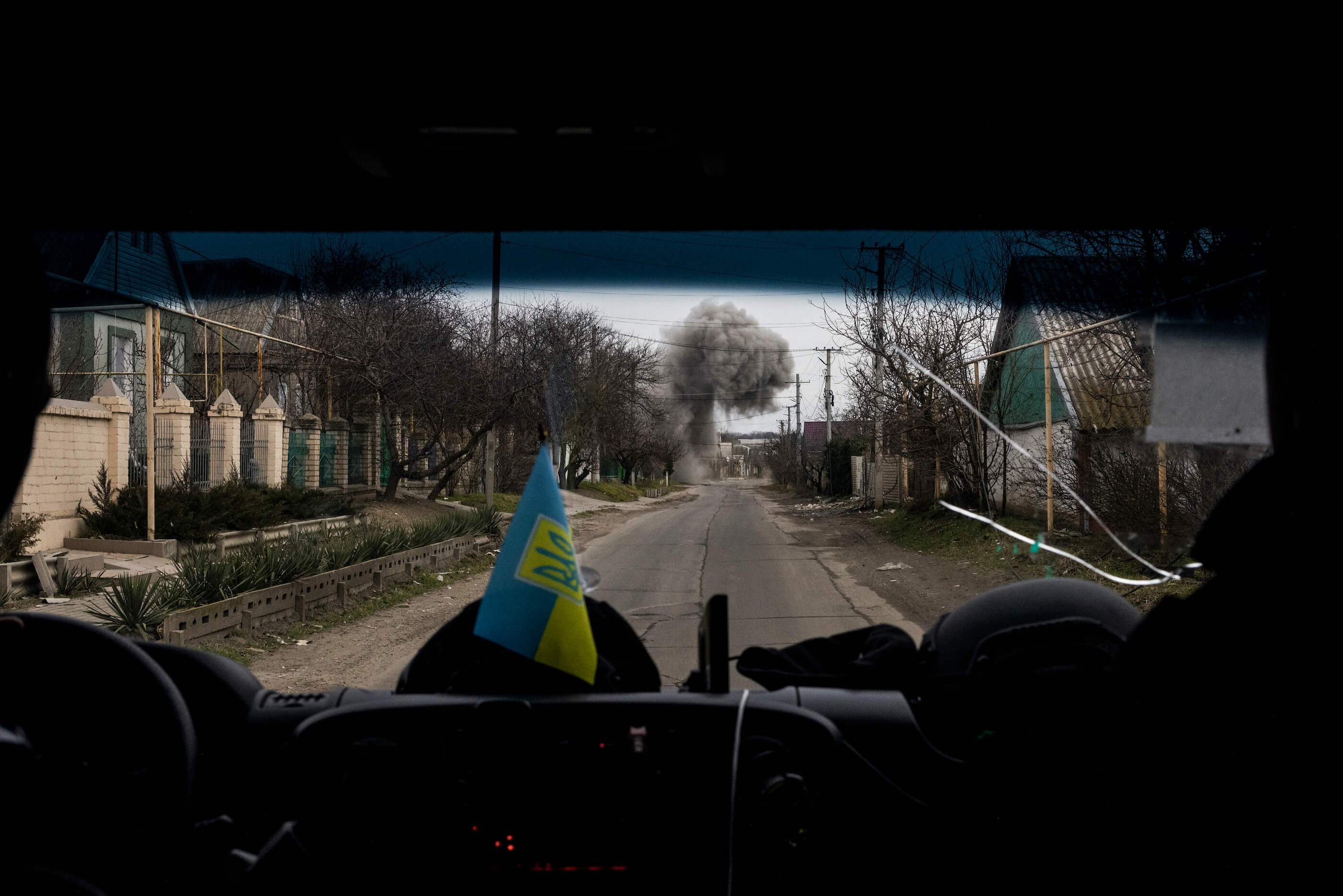
This is also in Kherson. We were following the mayor of Kherson for a couple of days. She is an incredibly tough woman, taking care of 40, 000 or 50, 000 people who are still living in the frontline city. This is not an easy job. One day, we were driving in her armored car, when a shell landed in front of us. We were near the Antonovsky bridge, in the neighborhood where her family used to live. I heard an explosion and saw smoke rising. And this is the last thing you want to see in front of you when driving a car. It seemed to me that the Russians spotted our car and tried to shell it. We had to turn around and go back. And as soon as we turned around, a second strike came in, very close to us. So they were definitely targeting the car.
Covering war is a dangerous pursuit. But I believe that war coverage plays a very important role. Think about the first days of the full-scale invasion, when Ukraine didn’t have this support or even the weapons needed to defend itself. Without the journalists on the ground, their reports and images on The New York Times or on CNN, it would be much easier to ignore this war. More than ever in my career, I felt public support and unity. That’s why we keep doing our job.
New and best
